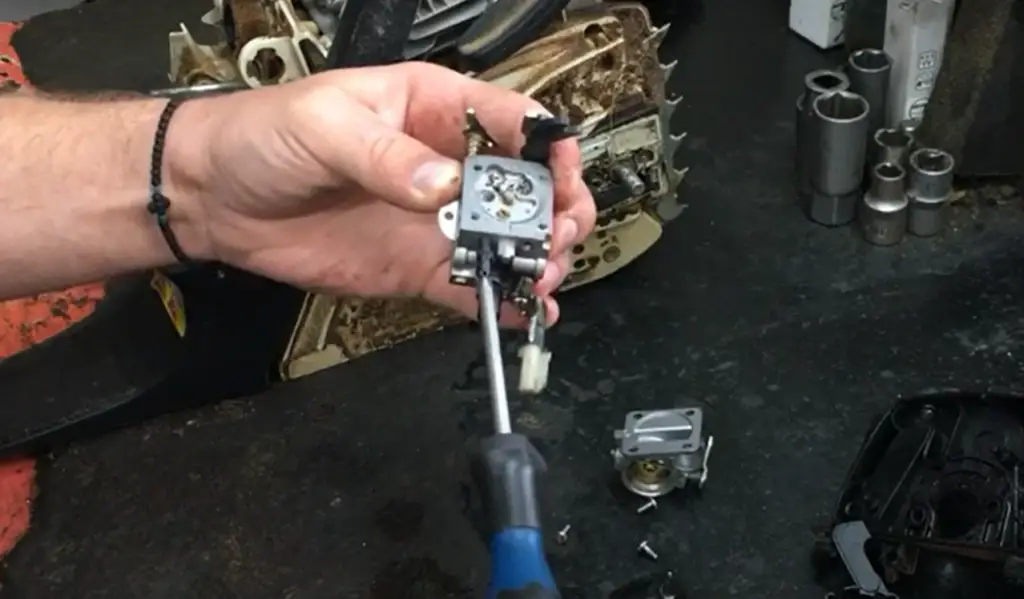Introduction:
Are you facing performance issues with your chainsaw, such as inconsistent idling, sputtering, or difficulty starting? If so, a clogged carburetor could be the culprit. Regular cleaning and maintenance of the carburetor are crucial for ensuring seamless operation and prolonging the life of your chainsaw. This guide will provide you with a step-by-step roadmap for effectively cleaning a carburetor on a chainsaw. Whether you’re a seasoned mechanic or a DIY enthusiast, this comprehensive guide will empower you with the knowledge and confidence to restore your chainsaw to pristine condition.

Image: www.slideshare.net
Delving into Carburetors:
A carburetor is the heart of your chainsaw’s fuel system, responsible for mixing air and fuel in precise proportions to create a combustible mixture. Over time, this mixture can accumulate dirt, debris, and varnish inside the carburetor, hindering its proper functioning. Cleaning the carburetor involves disassembling it, removing these contaminants, and reassembling it for optimal performance.
Step-by-Step Cleaning Guide:
Materials Required:
- Carburetor cleaner
- Soft cloths or rags
- Screwdrivers (Phillips and flathead)
- Needle-nose pliers
- Replacement gasket (if necessary)
Process:
1. Safety Precautions and Preparation:
- Wear protective gear, including gloves and safety glasses, throughout the process.
- Disconnect the spark plug lead to prevent accidental starting.
- Place the chainsaw on a stable surface and allow it to cool down if recently used.
2. Locating and Disassembling the Carburetor:
- Locate the carburetor, usually mounted near the engine.
- Remove the air filter and any external components attached to the carburetor.
- Unscrew the mounting bolts or screws securing the carburetor to the engine.
- Disconnect the fuel line and throttle linkage from the carburetor.
3. Disassembling the Carburetor:
- Hold the carburetor vertically and unscrew the top cover using a Phillips screwdriver.
- Remove the diaphragm and its associated spring.
- Use a flathead screwdriver to gently remove the jets (main jet, pilot jet, and idle jet).
- Separate the carburetor body from the float chamber and carefully remove the float.
4. Cleaning and Inspection:
- Spray carburetor cleaner generously into all passages, jets, and other internal components.
- Use a soft cloth or rag to gently wipe away any loosened dirt or debris.
- Inspect the jets and passages for clogs or blockages, using a needle-nose pliers if necessary.
- Check the float for any damage or leaks.
5. Reassembling the Carburetor:
- Replace the float and reattach the float chamber to the carburetor body.
- Install new jets if necessary, ensuring they are tightened securely.
- Reassemble the diaphragm and spring, then replace the top cover.
6. Reinstallation and Testing:
- Connect the fuel line and throttle linkage to the carburetor.
- Secure the carburetor to the engine using mounting bolts or screws.
- Reconnect the spark plug lead.
- Start the chainsaw and test its operation. Adjust the idle speed and carburetor screws as necessary.
Maintaining Optimal Carburetor Performance:
- Use high-quality fuel and fuel additives to prevent varnish buildup.
- Clean the carburetor regularly, especially after prolonged storage or heavy use.
- Check the air filter and replace it when dirty to prevent dirt from entering the carburetor.
- Store the chainsaw with the carburetor empty to prevent fuel from gumming up the system.

Image: polesawguide.com
How To Clean A Carburetor On A Chainsaw
https://youtube.com/watch?v=5mw34o4GHBk
Conclusion:
With a bit of patience and attention to detail, mastering the art of carburetor cleaning will empower you to restore and maintain the performance of your chainsaw for years to come. Remember to follow the steps outlined in this guide, exercise caution, and use high-quality replacement parts when necessary. By keeping your carburetor clean, you’ll ensure seamless operation, extended chainsaw life, and the satisfaction of tackling projects with confidence.